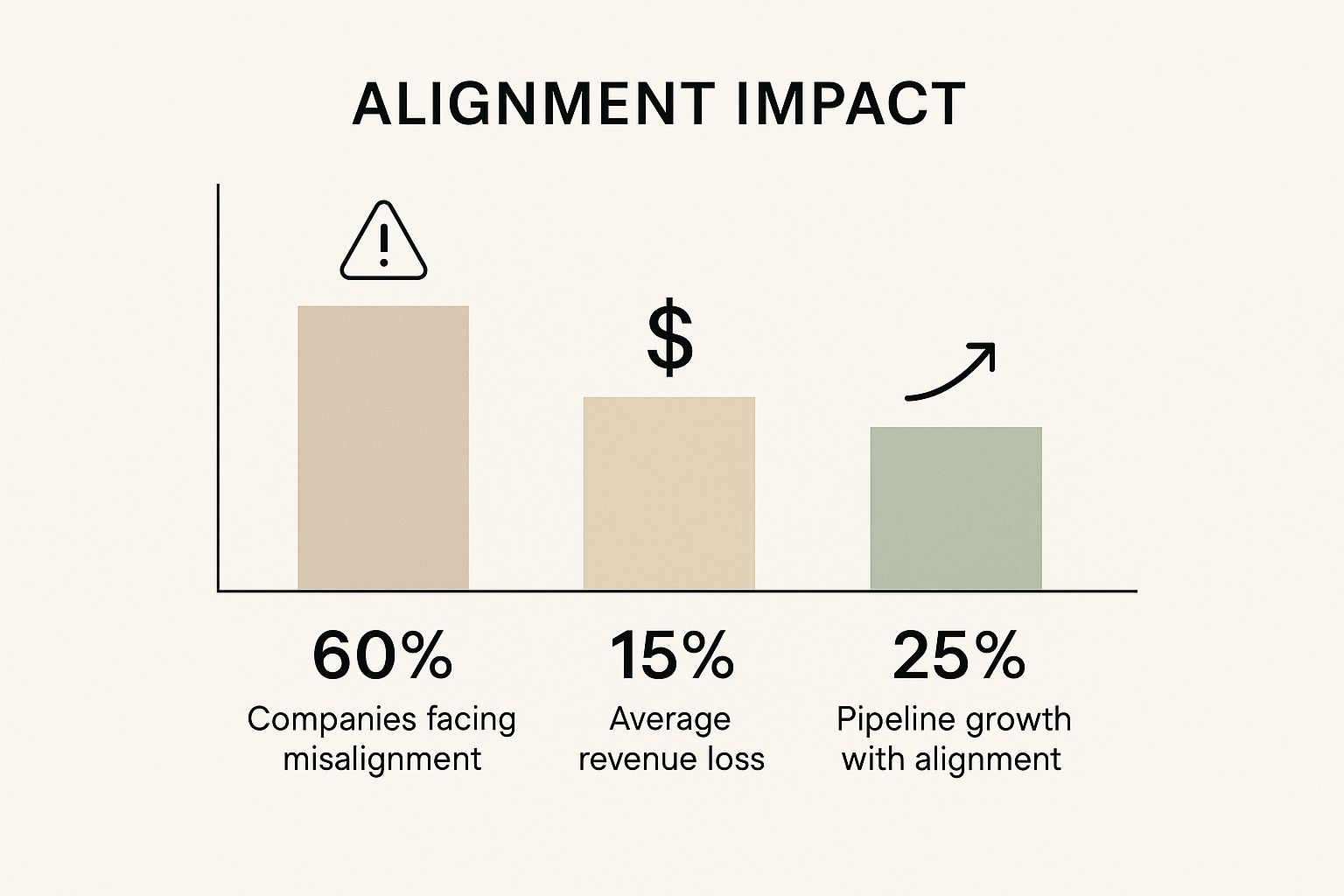B2B marketing and sales alignment isn't just corporate jargon; it's a strategic imperative. It’s the process of uniting two critical teams—marketing and sales—into a single, cohesive force. The objective is to create a seamless, consistent customer journey, from the first marketing touchpoint to the final signed contract.
The Power of Unified B2B Teams

Imagine your marketing and sales departments as two rowers in a boat. When they paddle in sync, the boat glides forward with speed and precision. But if they're out of sync, the boat just spins in circles. This circular motion is a common reality in many companies, leading to wasted resources, frustrated teams, and stalled revenue.
This guide provides practical steps to forge a genuine partnership between marketing and sales. We'll move beyond high-level theory to focus on actionable strategies that result in a superior customer experience, higher-quality leads, and sustainable business growth.
The Cost of Misalignment
Before building bridges, it's essential to understand the chasm that often separates these teams. When marketing and sales operate in silos, the negative consequences ripple throughout the organization.
- Wasted Budgets: Marketing spends resources on campaigns that generate leads sales deems unqualified. In turn, sales reps waste valuable time sifting through a pipeline of prospects with low purchase intent.
- Frustrated Teams: A culture of blame often emerges. Marketing feels their efforts are ignored, while sales believes they lack adequate support. This environment erodes morale and leads to high employee turnover.
- Lost Deals: This is the most significant impact. Prospects receive conflicting messages—one from a marketing campaign and another from a sales representative. This disjointed experience erodes trust and sends them directly to competitors.
Misalignment is more than an operational headache; it's a direct threat to profitability. It creates friction where momentum is needed, turning the customer journey into an obstacle course rather than a clear path to purchase.
The Advantage of a Unified Strategy
Conversely, companies that master alignment gain a significant competitive edge. The data supports this claim: organizations with strong alignment achieve 19% faster revenue growth and 15% higher profitability.
Even more compelling, aligned companies report a 208% increase in marketing-generated revenue. This is because the friction is eliminated. This unity fosters a culture of shared accountability, where every team member understands how their work contributes to the ultimate metric: revenue. You can explore more data on how sales and marketing collaboration boosts business growth.
In the following sections, we'll outline a roadmap for dismantling silos and building a high-performance revenue team.
Why Sales and Marketing Teams Clash
To build a bridge between sales and marketing, one must first understand the chasm that separates them. This friction stems from deep, systemic issues that often place these two essential functions at odds.
From marketing’s viewpoint, the primary frustration is wasted effort. They invest time, budget, and creativity into campaigns that generate a pipeline of promising leads, only to see them languish in the CRM. The lack of follow-up from sales can feel like a dismissal of their hard work, leading them to question the value of their contributions.
On the other side, the sales team is under immense pressure to meet quotas. They receive a high volume of leads from marketing, but often find them to be unqualified, uninterested, or simply not ready for a sales conversation. Sifting through these leads feels like a major drain on their time, fostering skepticism about marketing's efforts.
The Core of the Conflict
This classic disconnect is typically fueled by misaligned goals and disparate languages. Marketing is often measured by top-of-funnel metrics like lead volume and brand engagement. Sales, however, is evaluated almost exclusively on closed-won revenue. This creates a fundamental conflict from the outset.
At its heart, the clash is about perspective. Marketing celebrates a campaign that generates 1,000 new leads. Sales sees 950 unproductive conversations and views the entire initiative as a failure. Without a shared definition of success, both teams are set up for conflict.
The financial and operational consequences of this divide are substantial. The infographic below highlights the prevalence of this misalignment and its direct impact on the bottom line.

This data makes it clear: misalignment is a direct threat to growth. True b2b marketing and sales alignment is not accidental—it requires a deliberate, strategic effort to close these operational gaps and create a healthier pipeline.
Common Points of Misalignment: Sales vs. Marketing Perspectives
To understand the friction, it helps to compare the differing viewpoints. The table below illustrates the typical perspectives that cause conflict between unaligned sales and marketing teams.
These conflicting priorities create a constant tug-of-war where both teams feel misunderstood and undervalued. Bridging this gap requires finding common ground on these core issues.
Mismatched Definitions and Broken Communication
One of the most damaging symptoms of this divide is the mismatched definition of a "qualified lead." This single point of failure can derail an entire go-to-market strategy.
It's a significant barrier—a staggering 62% of companies report that their sales and marketing teams define 'qualified leads' differently. This inefficiency grinds the sales process to a halt and wastes resources on prospects who were never going to buy. With nearly half (47%) of B2B sales organizations missing their revenue targets recently, it's clear these alignment problems are taking a serious toll on pipeline health.
This communication breakdown creates a vicious cycle:
- Marketing delivers leads they consider "hot."
- Sales finds these leads to be lukewarm at best, eroding trust in marketing's judgment.
- Marketing receives no feedback and continues the same playbook, unaware of the disconnect.
Without a unified framework, both teams operate in silos, making assumptions that only fuel more resentment. The first step toward fixing the problem is diagnosing these exact symptoms inside your own organization.
How to Build a Foundation for Unbreakable Alignment
Effective B2B marketing and sales alignment is built intentionally. It requires a shared framework that eliminates guesswork and establishes clear rules of engagement. This foundational work transforms good intentions into a reliable, repeatable process that drives revenue growth.
The cornerstone is a shared language. When teams operate with different definitions, communication breakdowns are inevitable. The first step is for sales and marketing to collaboratively define what constitutes a "good" lead at every stage of the funnel.
Co-Creating Universal Lead Definitions
The most critical initial step is to establish universal definitions for a Marketing Qualified Lead (MQL) and a Sales Qualified Lead (SQL). This is not a task for marketing to handle alone; it must be a collaborative workshop where both teams contribute their expertise.
Marketing brings engagement data—identifying which content downloads, webinar sign-ups, or website behaviors indicate strong interest. Sales provides on-the-ground intelligence—specifying which job titles, company sizes, or pain points signal a prospect's readiness for a sales conversation.
- Marketing Qualified Lead (MQL): This defines the precise moment a lead has shown enough interest to be handed off. The definition must be specific, such as: "Downloaded the pricing guide AND visited the product page three times this week."
- Sales Qualified Lead (SQL): This is the point at which sales has vetted the MQL and confirmed it as a legitimate opportunity. These criteria are often based on frameworks like BANT (Budget, Authority, Need, Timeline).
By defining these terms together, you eliminate the single greatest source of friction. Sales gains clarity on what to expect, and marketing has a precise target to aim for.
Establishing a Service Level Agreement
With shared definitions in place, it's time to formalize commitments in a Service Level Agreement (SLA). Think of the SLA as the official rulebook for your revenue engine—a formal pact that ensures mutual accountability.
A robust SLA outlines concrete, measurable promises:
- Marketing's Commitment: Marketing agrees to deliver a specific number of qualified MQLs that meet the agreed-upon criteria each month or quarter. For example, "Marketing will deliver 150 MQLs per month with a lead score of 75 or higher."
- Sales' Commitment: In return, sales commits to following up on those MQLs within a strict timeframe and making a minimum number of contact attempts. For instance, "Sales will contact every MQL within 4 business hours and make at least 5 follow-up attempts before marking it as disqualified."
An SLA isn't about assigning blame; it's about building a predictable system. It ensures that valuable leads don't go cold and that the sales team focuses its efforts on the most promising opportunities.
Implementing and refining these agreements is often facilitated by a powerful marketing automation platform. To learn more about setting up the necessary technology, explore our guide on marketing automation implementation.
Shifting to Unified Revenue Goals
Finally, the most impactful change is to replace separate departmental goals with a single, shared focus on revenue.
When marketing's primary KPI is "number of leads" and sales' is "closed deals," their motivations can diverge. Marketing might prioritize quantity over quality to hit its target, overwhelming sales with ill-fitting prospects.
Shifting to a shared revenue goal changes the entire dynamic. Both teams become laser-focused on the same outcome. Instead of siloed KPIs, they share responsibility for metrics like pipeline velocity, customer acquisition cost (CAC), and the ultimate revenue number. This structure necessitates collaboration, as one team cannot succeed without the other, fostering a culture where everyone wins together.
Driving Daily Collaboration Between Teams

You have shared goals and a Service Level Agreement (SLA). That's an excellent foundation, but sustained success is achieved through daily execution. An SLA remains a document until it is brought to life through consistent interaction. This is where aligned teams excel, turning a strategic plan into a revenue-driving reality.
Regular, structured meetings designed for collaboration are key to maintaining momentum. These "Smarketing" (Sales + Marketing) meetings serve the single purpose of ensuring both teams are working in unison.
The Smarketing Meeting Cadence
A weekly Smarketing meeting should be the operational heartbeat of your revenue teams. This isn't just another calendar invite; it's a dedicated workshop for overcoming roadblocks and identifying opportunities. A vague agenda is a waste of time. To make these sessions impactful, focus on metrics and activities that directly contribute to the pipeline.
A strong Smarketing agenda includes:
- Pipeline Health Review: Go beyond the numbers to understand why deals are stalling. Are there common objections? Is a particular piece of collateral causing confusion? Brainstorm solutions collaboratively.
- MQL and SQL Feedback: This is crucial. Sales should provide specific, honest feedback on the leads received. Which were high-quality and why? Which were not? This real-time input helps marketing refine its targeting immediately.
- Campaign Performance Discussion: Marketing shares insights on current campaigns. Which email subject lines are performing well? What content is driving meaningful engagement? This information prepares sales for conversations with informed prospects.
The Smarketing meeting is the ultimate accountability loop. It transforms the dynamic from "us vs. them" to "we," with both teams actively solving the same pipeline challenges.
This constant dialogue is the essence of effective B2B marketing and sales alignment. Best practices indicate that when teams co-own messaging and campaign strategy, everyone benefits. This requires real-time communication, making shared channels in platforms like Slack or Microsoft Teams ideal for quick feedback. For more insights, explore this article on building this collaborative environment on Demandbase.com.
Creating a Closed-Loop Feedback System
Beyond meetings, your technology stack can facilitate a continuous feedback channel. A properly configured CRM should serve as the central nervous system, acting as the single source of truth for every prospect interaction. When sales can provide real-time feedback on lead quality directly within the CRM, marketing gains immediate visibility.
This closed-loop system shows marketing the outcome of their efforts. Did a lead from a recent webinar convert to an opportunity faster than average? Was an ebook download immediately disqualified? This data is vital for refining campaigns and allocating budget to revenue-driving activities.
The Power of Co-Creating Content
One of the most potent collaborative activities is co-creating content. When marketing develops assets in isolation, they are often making educated guesses about customer pain points. Involving sales representatives in the process ensures the final product directly addresses real-world objections and questions.
Consider these effective co-creation strategies:
- Webinars: Have a top sales representative co-host a webinar with a marketing team member. The rep brings authentic field stories and credibility, while marketing ensures the presentation is polished and well-promoted.
- Case Studies: Interview both the customer and the sales representative who closed the deal. The rep can provide the complete narrative—the initial pain points, the "aha" moment, and the specific results that sealed the deal.
- Blog Posts: Ask your sales team: "What are the top five questions you hear from prospects every week?" Transform their answers into a blog post, creating a valuable sales enablement tool.
When sales reps contribute to content creation, they become invested in its success and are more likely to use and share the assets, turning marketing materials into effective tools for closing deals.
Measuring Success with Unified Metrics

A solid strategy and daily collaboration are essential, but as the adage goes, "If you can't measure it, you can't improve it."
True B2B marketing and sales alignment is proven not in meetings, but on a shared dashboard. It's time to abandon the siloed metrics that fuel conflict—such as marketing's focus on "lead volume" versus sales' focus on "calls made"—and adopt unified KPIs that tell the complete story of your revenue engine.
This approach shifts the focus from two separate scorecards to one unified scoreboard for the entire company. When everyone is looking at the same data, the conversation moves from blame to collaborative problem-solving. A funnel bottleneck is no longer a "sales problem" or a "marketing problem"—it's a revenue problem that everyone is motivated to solve together.
From Siloed Reports To A Shared Dashboard
The objective is simple: track the entire customer journey, from the first marketing touchpoint to the final closed deal. This requires a shared dashboard that integrates data from your CRM and marketing automation platform, providing everyone with a real-time view of performance.
This transparency builds trust and empowers teams to make smarter, faster decisions based on reality, not assumptions.
By adopting unified metrics, you create a common language based on data. It replaces subjective opinions with objective facts, allowing teams to diagnose funnel issues with precision and make collaborative, data-backed decisions that drive real growth.
This is the foundation of any modern, effective campaign. Building this analytical capability is a game-changer. You can get a head start by exploring powerful data-driven-marketing-strategies">data-driven marketing strategies that turn raw numbers into action.
The KPIs That Truly Matter For Alignment
While every business is unique, several key metrics are non-negotiable for any organization serious about alignment. These KPIs directly link marketing activities to sales outcomes, making the impact of collaborative efforts undeniable.
Tracking individual metrics for each team is a recipe for misalignment. Marketing might hit its lead quota, but if those leads don't convert, Sales sees it as a failure. Conversely, if Sales struggles to close, they might blame lead quality without any data to back it up. A shared dashboard with unified KPIs solves this by painting a complete picture of the entire revenue journey.
Key Metrics For Aligned Sales And Marketing Teams
By focusing on these shared outcomes, both teams are held accountable for the same goal: revenue. The conversation changes from "my numbers" to "our numbers."
Using Shared Data For Continuous Improvement
Your shared dashboard is more than a reporting tool; it's a diagnostic instrument for your revenue engine. Reviewing these unified metrics together in Smarketing meetings allows you to spot trends that would be invisible in siloed reports.
For example, you might discover that leads from a particular webinar series have a 25% higher lead-to-customer conversion rate than any other channel. This is a clear signal for both teams.
Marketing knows to double down on that type of content. Sales knows to prioritize follow-up with those attendees. This data-driven feedback loop is what elevates a good go-to-market strategy to a great one.
Using Technology to Power Alignment
Strategy meetings and shared goals provide the blueprint, but technology is the high-performance engine that brings alignment to life, especially at scale. Without the right integrated tools, even the best intentions can be undermined by manual processes and disconnected data. Your tech stack should function as the central nervous system of your organization, enabling the seamless flow of information between teams.
This is how you eliminate the data silos that cause classic friction between sales and marketing. When everyone operates from the same playbook, arguments over lead quality or follow-up times disappear, replaced by productive, data-driven conversations about process improvement.
The CRM as the Single Source of Truth
At the core of any aligned tech stack is the Customer Relationship Management (CRM) platform. It must be treated as the undisputed source of truth for every prospect and customer interaction. When both sales and marketing operate within the same CRM, it becomes the central hub where all data converges.
This creates a transparent, 360-degree view of the customer journey. Marketing can trace a lead’s entire history, from their first website visit to the moment they become a sales-qualified opportunity. In turn, sales gains full context on every blog post read, email opened, and webinar attended, arming them with valuable insights before they even initiate contact.
Integrating Key Platforms for Seamless Handoffs
While a CRM is powerful, its true potential is realized when connected with other critical tools. Integration automates crucial handoffs between marketing and sales, preventing common points of failure.
- Marketing Automation Platforms: Tools like HubSpot or Marketo integrate directly with the CRM, feeding a continuous stream of lead intelligence—such as content downloads and page views—to the sales team. This provides reps with powerful context for their outreach.
- Sales Enablement Tools: Platforms such as Seismic provide sales reps with instant access to the latest, marketing-approved content within their daily workflow. This ensures every rep uses on-brand, effective materials that advance deals.
- Revenue Intelligence Platforms: Solutions like Gong analyze sales calls and customer conversations, extracting invaluable feedback. This data is a goldmine for coaching sales reps and helps marketing fine-tune messaging to address real-world objections.
When these systems are integrated, the technology itself reinforces the processes you've built. It transforms alignment from a theoretical goal into an automated, efficient, and scalable reality that directly fuels revenue growth.
Got Questions About B2B Alignment? We’ve Got Answers.
Implementing significant organizational change naturally raises questions. Here are answers to some of the most common inquiries from leaders embarking on the journey to unite their marketing and sales teams.
How Quickly Can We Expect To See Results?
While you will likely notice an immediate improvement in team morale and communication, significant financial results require patience. Expect to see progress in leading indicators—such as lead acceptance rates and pipeline velocity—within the first 90 days.
However, for lagging indicators like revenue growth and a reduction in customer acquisition cost, a timeframe of six to twelve months is more realistic. Success comes not from a single initiative, but from consistent execution of the fundamentals: maintaining focus on shared goals, holding regular Smarketing meetings, and ensuring data transparency.
What Is The Single Biggest Hurdle To Overcome?
The most significant roadblock is almost always cultural. Deep-seated habits, historical friction, and a lack of trust can be challenging to overcome. This is where strong, unified leadership from the heads of both sales and marketing is crucial.
The fastest way to dismantle cultural barriers is by creating shared wins. When both teams collaborate on a campaign that exceeds its revenue target, it builds the trust and momentum needed to make alignment the new standard.
Both leaders must champion this new collaborative approach. They need to publicly celebrate joint successes and hold their teams accountable to the commitments outlined in the Service Level Agreement (SLA).
Who Should Own The Shared Revenue Target?
While everyone is responsible for contributing to the revenue target, ultimate ownership should be clear. Increasingly, companies are creating a Chief Revenue Officer (CRO) role to oversee marketing, sales, and customer success.
This structure eliminates the "us vs. them" dynamic by placing all revenue-generating functions under a single, unified vision. If a CRO role is not feasible, the CEO must serve as the final arbiter, holding both sales and marketing leaders jointly accountable for the shared revenue goal.
Ready to build an unbreakable bridge between your sales and marketing teams? Twelverays specializes in integrating your CRM and marketing platforms to create a single source of truth, fueling your growth with data-driven strategies. Get in touch with us today to see how we can align your teams for measurable success.
Related B2B Sales & Marketing Resources
Successful B2B marketing and sales alignment requires integration with comprehensive growth strategies. Explore these related resources to maximize your revenue team performance:
- B2B Digital Marketing Strategies - Build marketing programs that support sales goals
- B2B SaaS Marketing Strategies - Specialized alignment tactics for SaaS companies
- Customer Retention Strategies - Align teams around customer success and growth
- Data-Driven Marketing Strategies - Use analytics to optimize sales and marketing performance
By combining marketing and sales alignment with these strategic approaches, you'll create a unified revenue engine that drives consistent, predictable business growth.





